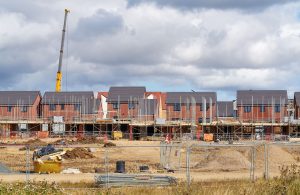Chancellor of the Exchequer, Philip Hammond delivered his first Autumn Budget on 22 November 2017, after annual Budget announcements moved to publication in Autumn, rather than Spring. The LexisPSL Planning and Construction teams bring together the most important features for the infrastructure and housebuilding sectors.
The full text of the Autumn Budget 2017 is available here.
What are the Budget’s headlines for infrastructure and housebuilding?
Infrastructure
Much was said about existing efforts to invest in infrastructure: Crossrail and HS2 were mentioned as specific examples of how the government is supporting infrastructure growth. New announcements include:
- an increase in the National Productivity Investment Fund from £23bn to £31bn, to support innovation, upgrade infrastructure and underpin the government’s modern Industrial Strategy
- an update to the National Infrastructure and Construction Pipeline in December 2017, setting out a 10 year projection of public and private investment in infrastructure of around £600bn (this update had previously been expected in early 2017, see: LNB News 23/11/2016 87)
- use of the government’s purchasing power to drive adoption of modern methods of construction, such as offsite manufacturing (the Department for Transport, the Department of Health, the Department for Education, the Ministry of Justice, and the Ministry of Defence will adopt a presumption in favour of offsite construction by 2019 across suitable capital programmes)
- a programme for new homes and infrastructure in the Cambridge-Milton Keynes-Oxford corridor. This follows the National Infrastructure Commission’s (NIC) report on this topic published on 17 November 2017 (see: LNB News 20/11/2017 41)
- backing for the Northern Powerhouse and Midlands Engine with a new £1.7bn Transforming Cities fund, half of which be shared by the six areas with elected metro mayors to be spent on delivering local transport priorities, the remainder open for competition by other cities in England
- investing £300m to ensure HS2 infrastructure will accommodate future Northern Powerhouse and Midlands Engine rail improvements
- a new NIC study on the future of freight infrastructure, to be published in spring 2019
- support for electric vehicles in the form of a new £400m charging infrastructure fund, an extra £100m plug-in car grant and an additional £40m for charging research and development
- a new £200m clean air fund funded by additional taxes on diesel cars
- introduction of a VAT domestic reverse charge to prevent VAT losses (following a consultation into options for tackling fraud in construction labour supply chains)
In relation to Crossrail 2, which had not been referred to at all in the Spring Budget this year, the Chancellor said:
The government recognises the need for investment in London’s infrastructure to support its growth, and will continue to work with Transport for London on developing fair and affordable plans for Crossrail 2, including through an independent review of funding and financing.
Housebuilding
The Chancellor identified that the number of young people owning their own homes has dropped from 59% to 38%. He recognised that despite housebuilding standing at its highest rate since the last financial crisis, fixing the housing market will require spending money, planning reforms and intervention. In terms of financial commitments, the government will:
- spend, over the next five years, a total of at least £44bn of capital funding, loans and guarantees to support the housing market and boost the supply of skills, resources and building land and create the financial incentives to deliver at least 300,000 net additional homes a year on average by the mid 2020s
- invest an additional £1.5bn in the Home Building Fund, providing loans specifically targeted at supporting SMEs who cannot access the finance they need to build
- invest £630m in a small sites fund, to pay for infrastructure and remediation to unstick the delivery of small, stalled sites with capacity to deliver 40,000 homes
- invest a further £2.7bn to more than double the housing infrastructure fund
- spend £400m of loan funding for more for estate regeneration to transform run-down neighbourhoods and provide more homes
- commit £1.1bn fund to unlock strategic sites, including new settlements and urban regeneration schemes
- lift Housing Revenue Account borrowing caps for councils in high demand areas, to help them build more social housing—councils will be able to bid for increases in their caps from 2019-20, up to a total of £1bn by the end of 2021-22
- commit £8bn of financial guarantees to support private housebuilding and the private rented sector
- provide an addition £34 m to develop construction skills
- bring together public and private capital to build five new garden towns, using appropriate delivery vehicles such as development corporations, including in areas of high demand such as the South East
Planning reforms were promised. The focus will be on:
- making best use of urban areas where people want to live and most jobs are created. Green belt protections will continue. High quality and high density development in city centres and around major transport hubs will be supported; an announcement for the Secretary of State for Communities and Local Government will set out more detail on how councils in high demand areas will grant more permission for local first time buyers and affordable renters
- closing the gap between the number of planning permissions granted and the number of homes delivered by carrying out an urgent review of the reasons for this. An interim report will be published in spring 2018. If this finds that land is being held back from the market for commercial rather than technical reasons, direct interventions (including through compulsory purchase if necessary) will follow to ensure the incentives change to ensure such land is brought forward for development
- funding and delivering infrastructure to support higher density development, by expanding the Homes and Communities Agency into a new body, called Homes England, which will bring together funding, planning and compulsory purchase powers with a clear remit to facilitate delivery of sufficient new homes where they are most needed to deliver a sustained improvement in affordability
- providing an addition £1.1bn for a new Land Assembly Fund which will enable Homes England to work alongside private developers to develop strategic sites, including new settlements and urban regeneration schemes
- consulting on developer contributions, which will propose: removing restrictions on section 106 pooling, speeding up the process of setting and revising the Community Infrastructure Levy (CIL) to allow authorities to set rates which better reflect the uplift in land values between proposed and existing uses, and changing indexation of CIL rates to house price inflation (rather than build cost)
The government will also support more strategic and zonal planning approaches through housing deals in the South East, where housing need is at its most acute. A housing deal with Oxfordshire has been announced, part of its wider strategic investment in the Cambridge-Milton Keynes-Oxford corridor, where Oxfordshire will bring forward for adoption a joint statutory spatial plan and commit to a target of 100,000 homes by 2031, in return for a package of government support over the next five years, including £30m a year for infrastructure and further support for affordable housing and local capacity.
The government is also continuing housing deal negotiations with Greater Manchester, the West Midlands, Leeds and the West of England.
Additionally, pledges were made to:
- introduce legislation to allow councils to charge a 100% council tax premium on empty properties
- consult on barriers to longer tenancies in the private rented sector, and how landlords can be encouraged to offer longer tenancies to tenants who want the extra security
- invest £28m in three new pilot schemes to reduce homelessness in the West Midlands, Manchester and Liverpool, and establish a new homelessness task force to half rough sleeping by 2022 and eliminate it by 2027
Our overall verdict
Support in terms of spending on critical infrastructure will be widely welcomed and provide confidence that the infrastructure sector is underpinned by government support. Equally positive is the recognition in the Autumn Budget 2017 that infrastructure provision leads to economic growth and regeneration, with a heavy focus on areas outside of London benefitting from investment. Also of interest is the government’s support for the adoption of modern construction techniques (for example offsite construction)—while it falls short of a mandate (as has been the case for the use of building information modelling) for offsite construction, such a move is nonetheless progressive.
The financial commitments to support housebuilding will no doubt be well-received, although as perhaps expected, much of the focus is on building new homes to enable young people to become home owners and there is little other than financial guarantees and a promise to look at longer tenancies for long-term renters and the private rented sector generally. Large house-builders will not welcome the underlying allegations that land-baking is holding back delivery and it is frustrating that a further consultation on CIL is promised, given the wide-ranging CIL Review carried out in 2015/2016. Announcements on planning reform and intervention are also very thin on detail, and while the expansion of the Homes and Communities Agency is a positive move, it already possesses compulsory purchase powers, so it is unclear how it will now be incentivised to use those powers to drive up delivery.
Source: LexisNexis Purpose Built
The Autumn 2017 Budget—infrastructure and housebuilding announcements



